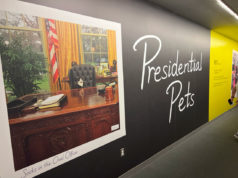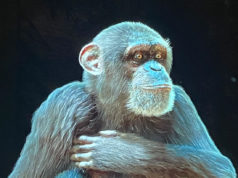The corridor is kind of creepy. Long. Dimly lit. Looks like it’s empty all the time. Very ax murderer-y. Located on the second floor of Tarrant County College’s Southeast Campus, this stretch of vinyl tile is definitely hair-raising –– even when the lights are up –– but it offers Christopher Blay room to flip wigs. Not with a blood-stained ax in hand, though. With art.
Veteran multimedia artist Blay curates Art Corridor II, that shadowy patch of second-floor collegiate real estate, and since assuming the position a couple of years ago, the fortysomething Fort Worthian has managed to talk some pretty heady rising local stars into gracing his space. His gallery’s current exhibit, Falloff, features two established but still fringe-dwelling multimedia Fort Worth artists: Timothy Harding and Kris Pierce. Though small and slightly unfocused, the show is seriously lighthearted and, in its stilled weirdness, complementary to the gallery.
Falloff is a staunchly conceptual exhibit. If there seems to be a wellspring of outré art in sleepy ol’ Panther City, that’s because there is. Blay joined Art Corridor II around the same time two other thought-provoking galleries –– Brand 10 Art Space and Fort Worth Contemporary Arts –– opened their doors. Out in the wilds of ye olde Forte, multimedia artist Cecil Touchon began pushing his Fluxus group, and some MFA candidates at Texas Christian University and their friends launched HOMECOMING Committee, an informal art collective that’s really just a glorified excuse to throw parties and screw with art. The HOMECOMING folks have been quiet recently, but their last project, in May, was Hands on an Art Body, an endurance contest/art auction modeled after Hands on a Hardbody. Unlike the 1995 contest in which 24 residents of Longview, Texas, vied to keep their hands on a new Nissan Hardbody truck the longest to win it (the event immortalized on celluloid in 1997), Hands on an Art Body did not lead to anyone’s physical or mental collapse.
One of the committee’s co-founders is Pierce, who has been seen locally recently via “The Red Telephone.” Consisting of three payphones painted red and situated throughout town, Pierce’s virtual triptych was part of where is the power, an adventurous but slightly undercooked exhibit displayed recently at FWCA. (Recordings of random people speaking into the receivers can be heard at theredtelephone.net.) Exciting in theory but enervating in practice, “The Red Telephone” could be seen as a manifestation of the Fort Worth scene’s fascination with conceptual art: a one-way conversation between the artist and his or her four studio walls.
The rest of the art world seems obsessed with conceptual art’s maximalist strain, an expected but at least interesting response to the major events and circumstances sweeping the globe: overconsumption, overpopulation, rampant capitalism, equally rampant religious fundament-alism, militarization, inequality, you name it. As famed biologist Edward O. Wilson writes in his new book, The Social Conquest of the Earth, “We have created a Star Wars civilization, with Stone Age emotions.” But in the Fort, we, with some exception, are still gaga over minimalism, and while the results are not always sterile and ordinary, they tend to be insular and take as their main subject art. Isn’t art about art so 1962?
Does an artist have to be a multimillionaire to satisfy his or her big-thinking muse? Not really. HOMECOMING’s XLP-11, a “crewed/crude” spaceship, blends imposing size –– it was about as big as a compact car –– with a socially cognizant sensibility. The idea sprang up last summer after NASA announced plans to privatize space exploration. With XLP-11, HOMECOMING Committee is just throwing its trucker ballcap into the ring. Hilariously.
Maximalism also does not necessarily mean massive. Intricate and intense also qualify. Exhibit A: Pierce’s “A Challenger Appears,” ostensibly the centerpiece of Falloff. On a rectangular “screen” of a large hexagonal canvas and backing wall, horizontal rows of urban patois in purple capital letters –– “OMFG,” “SO LIKE TOTALLY,” “WUT?!?!?” –– whiz by. In front of them, on the centrally located canvas, a frenetic 8-bit fantasia pulses. Brilliant colors and symmetrical geometric patterns mobilize into an anime-influenced Hindu shrine of sorts. In the center, the tiny wings of a small, cartoonish orb flutter, radiating beams of white. Beneath it is another, larger cartoonish sphere, this one resembling the head of a bear with eyes –– crazily blinking, twinkling, glimmering eyes –– where his mouth should be. The overall visual effect is as eerily soporific as a hypnodisc.
Pierce clearly is fascinated with the antiquated computer technology (and probably played a lot of early-’80s video games as a kid). Two of his other pieces are also 8-bit works. In “11:11,” the faces of luminously colored but macabre slot machines roll on a loop across six small color-television screens arranged in a neat row. In place of 7s, BARs, and cherries and making up the background, wacky pop-culture objects (gnomes, flames, cupids, hamburgers, skulls) glow, illuminating the darkened corridor and creating the unsettling feeling of having stumbled upon hell’s version of Las Vegas. The seediness is unshakable.
Pierce’s other 8-bit piece, “My Secret History of Street Cred,” is a static projection of a young boy’s room, decorated with cheap furniture, a flat-screen TV, posters for the Sex Pistols and Blondie, a Big Gulp, a bong, a skateboard, an empty Red Bull can, a Godzilla figure atop a bookshelf, a still-smoking cigarette (a joint?), and other man-child ephemera, the entire tableau likely inspired by London artist Gary J. Lucken’s “Edge: Retro Gamers Room.”
Pierce’s remaining Falloff contribution, “Howl,” is a dizzying, choppily edited black-and-white short film of a guy in a Wolfman mask playing an electric guitar. His surroundings are dark, illuminated nauseatingly only by what appears to be a strobe light, and his, um, ax is outlined in white light. The soundtrack is squalling feedback, and the perspective is from the guitar’s bridge. The piece unites the exhibit.
The bright white streaks echo Harding’s sculptures nearby. Consisting of long, thin, colored fluorescent lightbulbs seemingly haphazardly situated on the gallery floor, the pieces are delightful a la Dan Flavin’s groundbreaking assemblages but are decidedly only about art. But while the young artist’s found-object mini-monuments may look lazy, they are in keeping with his oeuvre and his apparent mission statement: to create art that resists commodification. A member of HOMECOMING Committee and a Visionary Awards winner, Harding represents Fort Worth’s conceptual-art vanguard. You can’t buy most of his pieces or take them home with you. Large and unruly “wall drawings” in wires, light, paint, and other common media, they’re that maximalist. But you will be haunted by them.
[box_info]
Falloff by Kris Pierce and Timothy Harding
Thru Dec 15 at Art Corridor II, TCC Southeast Campus, 2100 SE Pkwy, Arlington. Free. 817-515-3522.
[/box_info]












